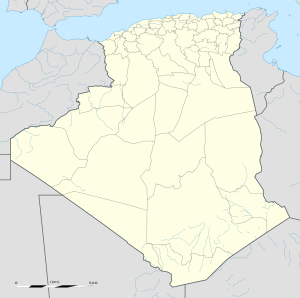Expedition to Mostaganem (1558)
| Expedition of Mostaganem | |||||||
|---|---|---|---|---|---|---|---|
| Part of the Ottoman-Habsburg wars | |||||||
| |||||||
| Belligerents | |||||||
|
|
| ||||||
| Commanders and leaders | |||||||
| Count Alcaudete † |
Hasan Pasha Abdelaziz El Abbes | ||||||
| Strength | |||||||
| 12,000+ soldiers | Unknown | ||||||
| Casualties and losses | |||||||
| 6.000 killed, 6.000 prisoners[3] | Unknown | ||||||
 Expedition of Mostaganem | |||||||
The Expedition of Mostaganem occurred in 1558, when Spanish forces attempted to capture the city of Mostaganem. The expedition was supposed to be a decisive step in the conquest of the Ottoman base of Algiers, but it ended in failure, and has been called a "disaster".[4]
Background[]
The harbour of Mostaganem had been captured by the Spanish from the Muslims in 1506. The harbour became part of numerous Spanish possessions on the coast of the Maghreb, which had been captured since 1496: Melilla (1496), Mers-el-Kebir (1505), Oran (1509), Bougie (1510), Tripoli (1510), Algiers, Shershell, Dellys, Ténès.[5]
In 1516, Mostaganem was seized by Hayreddin Barbarossa from his base of Algiers. He then strengthened its defences, and the city became a rival of Oran.[6] From 1519, Barbarossa placed himself under the protection of the Ottomans, thereby transforming Mostaganem into an Ottoman dominion.[5]
Previous Spanish expeditions had taken place in 1543 and 1547, which failed as the Spanish forces were repulsed and then pursued in retreat by Turkish and tribal forces.[7]
The expedition of 1558 to retake Mostaganem from the Ottomans followed a string of Ottoman successes in the Mediterranean, especially with the Siege of Tripoli in 1551, and the evacuation of Al-Mahdiyeh by the Spaniards.[4] Concurrently, the corsairs of Barbary were operating from their base in Algiers.[4]
Expedition[]
In the end, around 12,000 Spanish soldiers were taken prisoner.[8][9] Count Alcaudete, Governor of Oran, died in the expedition.[4] His son Don Martín de Córdoba, himself future Governor of Oran, was also captured in the disaster and would be imprisoned as a Christian slave in Algiers under the beylerbey Hasan Pasha, until he was exchanged for the huge ransom of 23,000 escudos.[8]
The failure of the expedition of Mostaganem ended attempts at a grand alliance between Spain and Morocco against the common Ottoman enemy.[10]
Notes[]
- ^ Hugh Roberts, Berber Government: The Kabyle Polity in Pre-colonial Algeria , IB Tauris , 2014, p. 195
- ^ Gaïd, Mouloud (1975). L'Algérie sous les Turcs (in French). Maison tunisienne de l'édition.
- ^ a b Micheal Clodfelter (9 May 2017). Warfare and Armed Conflicts: A Statistical Encyclopedia of Casualty and Other Figures, 1492–2015, 4th ed. McFarland. p. 25. ISBN 978-0-7864-7470-7.
- ^ a b c d Cervantes in Algiers: a captive's tale by María Antonia Garcés p.25
- ^ a b An Historical Geography of the Ottoman Empire p.107ff
- ^ "But as early as 1516 Mostaganem fell into the hands of the Turks. From then on, being the rival of Spanish Oran, it saw its importance increase." Algeria Hildebert Hisnard p.158
- ^ A history of the Maghrib in the Islamic period Jamil M. Abun-Nasr p.155
- ^ a b Cervantes in Algiers: a captive's tale by María Antonia Garcés p.49ff
- ^ Power and Penury: Government, Technology and Science in Philip II's Spain by David C. Goodman p.247
- ^ "the failure at Mostaganem, which brought the collapse of grandiose projects of alliance with Morocco" in MEDITERRANEAN AND THE MEDITERRANEAN WORLD IN THE: AGE OF PHILIP II -2 by Fernand Braudel p.855
- Conflicts in 1558
- Battles involving the Ottoman Empire
- Battles involving Spain
- 1558 in the Ottoman Empire
- Military expeditions
- Expeditions from Spain
- Ottoman–Spanish conflicts
- 1558 in Africa
